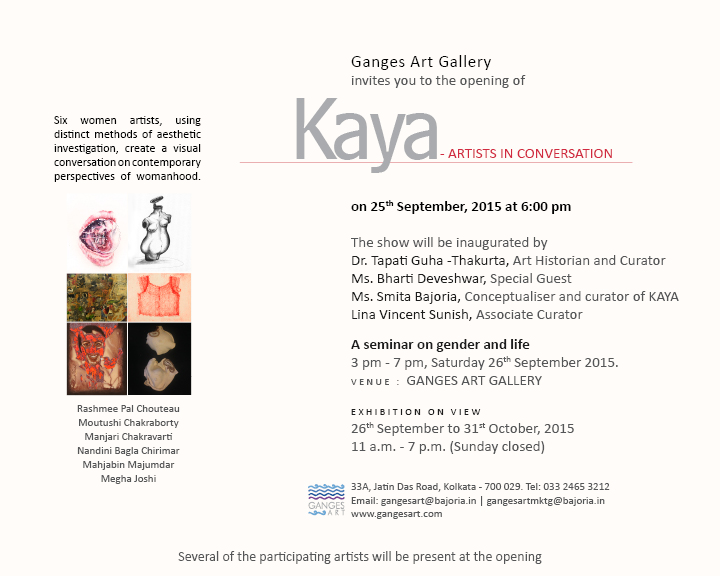Identity of women
We women, live our lives in many different roles and identities
as nurturers of the future generation.. of all the children who will inherit the earth…
as people who hold a family together….either a nuclear family or an extended one
as a daughter, wife, mother ….
as bread earners… from being scientists, astronauts and artists to more mundane tasks like selling vegetables.
Being Prime Ministers and Queens who rule countries to women who try to avoid exploitation as sex slaves…
As people who co -habit this planet to make it a more… beautiful, magical, fun, safe, equal and logical …
Smita Bajoria - Curator
The task of interpretation is a formidable one. And yet, one can derive a maximum amount of pleasure in entering into the artists’ worlds – these are sometimes charming, sometimes disturbing, at timesobscured under veils of mystery, otherwise ensconced in fragile bubbles of fantasy.
I have been on a journey with the six artists presenting their work in KAYA, and wondered along the way, in parts – does gender make itself felt in artistic expression? Is a woman’s identity indelibly tied to her aesthetic choices? The answers would require a lengthy survey, but the investigation did get me closer to understanding the artist’s works.
The Feminine Body, and Beyond
The woman’s body is often thought of as the receptacle that reproduces – the uterus, vagina and the breasts overpowering and perhaps obliterating the rest of the form. The same body parts make a woman a sexual object, subject to being pried upon, in thought and word and action, and never completely free of the burden of ‘being a female’. Her sensations, truths and existence are often manipulated to suit society’s conventions and demands.
In this series of work, Megha Joshi confronts the viewer with nipples – by objectifying them consciously, she is externalising her touchiness about the organ, and negating the ‘sexual’ tag by repeating it so many times and in so many places that it (ought to) become commonplace. The works narrate what many of us would like – to be rid of the tiredness of covering up, of arresting free movement and embrace being female, in an unrestrained way.
Moutushi uses symbolic and subtly nuanced imagery to speak about femininity and empowerment. There are references to nature’s fecundity, and the ability of the feminine gender to attract and repel, nourish and consume, love and destroy, in the same breadth. The body, often anonymous and headless, assumes a paradoxical position – something sensory is cut off, and yet it abounds with powerful energy. A further reference to archival images suggests a disconnection from contemporary reality.
Rashmee Pal Chouteau’sdrawings are saturated with colour, seemingly injected with sensation and emotion in each brush stroke. The richness of hues and detailed surface conceals a philosophical questioning of human nature, that reaches out to pain as much as ecstasy; she attempts to bridge gaps between need and want, between reality and dream. In her own words, she is searching for and capturing metaphors, creating elusive scenarios that provoke as much as beguile.
The Self, the Mind, the World
Women find a necessity to develop a dynamic and flexible understanding of life and self. There is a constant movement between private and public, secret and disclosed experience. There are layers or filters that become engrained in everyday life, imbuing a sense of parts rather than the whole. Fragmentation and dislocation allow something mundane like multitasking and provide access to multiple contexts at a given moment.
In MahjabinMajumdar’s works, there is a deep relationship between the visually constructed worlds and actual experience. She transposes the self in varied situations and environments, testing as it were, new atmospheres and conducive elements. Despite the notion of camouflage, the self, is for the artist, a recognisable, formidable presence, fitting into and yet enveloping the surrounding space. Text hangs in the air, providing pieces to the jigsaw of her universe.
Manjari Chakravarty utilises the relationship of text and image, physically and intellectually constructing pathways from one plane of understanding to another. Reflecting feminine spirit in the organic gathering of thoughts, the artist makes references to recognisable tales and characters; she also creates fantasy, allowing a scenario of existence that is part of her world while simultaneously being in a different dimension. Time stands still as past and future, reality and make-believe coincide and merge.
In NandiniBaglaChirimar’s work, the world seems observed through delicate filters, annunciating relationships between mundane objects and lineages. She derives her stories from everyday life, directing her artistic techniques of painting, printmaking and papermaking to achieving a distinct voice of feminine expression. Her work lies in the intersection of figurative and the abstract forms, as she frames particular moments in history (her own and that of the universe).
This project is an example of the way women are turning the gaze upon themselves and their gender; it may be grammatically wrong but they are their own muses. The artistic voices are representative of numerous human beings who seek equality in more ways than one. In the end, Feminism is an individual and subjective state of mind.
Lina Vincent Sunish – Associate curator
